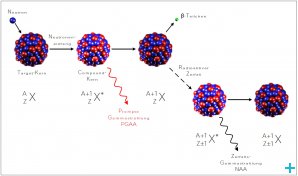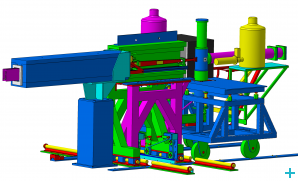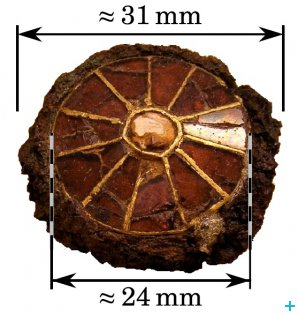German-Hungarian collaboration in PGAA
By Zsolt Révay and Petra Kudejova
Prompt Gamma Activation Analysis (PGAA) is a nuclear analytical technique, which is performed at several neutron beam facilities all over the world. It is based on the radiative capture of neutrons, whereby binding energy is released in the form of prompt gamma radiation when an atomic nucleus absorbs a neutron. If the nucleus is radioactive after de-excitation, it then decays with a delayed emission of a beta particle and gamma photons. Both types of gamma radiations are characteristic for each element: their energy identifies the emitter nuclide, while their intensity is proportional to its amount. In other words, the detection of these radiations enables the determination of the constituents of the sample analysed. The first process is used in prompt gamma activation analysis, while the radioactive decay in neutron activation analysis (NAA), see Figure 1.
In principle, all isotopes of all chemical elements can be analysed using PGAA, though with extremely different sensitivities. The great advantage of the method is that it is suitable for the analysis of light elements, where many instrumental analytical techniques fail. It is useful for the determination of the major and minor components of a sample, as well as for the analysis of certain trace elements like boron, cadmium, rare-earths, or hafnium. PGAA provides a unique tool for hydrogen or water analysis, too, as it is the only method allowing to investigate water solutions and trace amounts of hydrogen (or water) in materials. Since both neutrons and gamma photons penetrate deep into materials, the acquired gamma spectra contain analytical information about the whole irradiated sample. That is why PGAA makes possible the investigation of samples in any form, even samples inside containers with a wall thickness of several millimeters. With the right collimation of the neutron beam and of the out-coming gamma radiation, one can analyse internal parts of complex objects.
PGAA at BNC
The PGAA facility at Budapest started operating in 1995. The Budapest Research Reactor is a 10-MW water-cooled, water-moderated, tank-type reactor, also equipped with a cold neutron source. The PGAA facility is located 35 m away from the reactor at the end of a super-mirror-coated, curved neutron guide. The thermal flux at the sample position is 1.5×108 cm–2 s–1. One of the major projects of the group has been the establishment of spectroscopic library of capture gamma data and the development of the analytical procedures from detector calibration through spectrum evaluation to the determination of the composition of the sample. For the past 15 years, the major fields of application have been archaeology, geology and the investigation of nuclear materials. Measurements at this facility, similarly to other instruments at Budapest Neutron Center (BNC), are supported by NMI3.
PGAA at FRM II
The PGAA instrument at FRM II was originally developed at the Paul Scherrer Institute, Switzerland, where it was in operation from 1998 to 2001. The Nuclear Physics Institute of Cologne University, headed by Prof. Jan Jolie, then took over the responsibility for the instrument. Considerable work was first carried out in Cologne to re-design and upgrade the instrument. Then, in aprtnership with FRM II, the new PGAA facility was installed at the end of a 51 m long, curved cold-neutron beam guide NL4b (2006-2007). The instrument was tested in 2007 and opened to users in 2008. The thermal neutron flux can reach 6.1×1010 cm–2 s–1 – the highest cold flux ever reported. While keeping a good signal-to-noise ratio, the high neutron flux allows investigating very small samples (mg or below) or materials with extremely low neutron capture cross-section. Similarly to the Budapest PGAA, the scope of the measured samples and application is broad and includes archaeology, geology, environmental science, medicine, material science and irradiations.
Fruitful collaboration
Contact between the two PGAA groups started at the 11th Capture Gamma Symposium in Pruhonice, Czech Republic, in 2002. Both groups agreed to cooperate and the Budapest group offered their help and know-how in the rebuilding of the PGAA instrument at FRM II, and for the measurements and analyses. A number of visits and exchanges have taken place since the beginning of the project.
A joint research project was established in the frame of the ANCIENT CHARM project (EU NMI3/FP6) from 2006-2009. The two groups worked in close collaboration on the development of a new technique, Prompt Gamma Activation Imaging, driven by Neutron Tomography (PGAI-NT) for the investigation of precious cultural heritage objects. One of these objects was a fibula from the 6th century found in western Hungary (see figure 3), which was investigated at both laboratories using the PGAI-NT technique. Without disassembling the precious jewel, its internal structure and composition could be studied in detail. Its origin, most probably a German workshop, could also be determined using this technique.
The collaboration continues, with the measurements of low-cross-section nuclides at FRM II, in order to further improve the spectroscopy database. Zsolt Revay from Budapest is currently working as PGAA instrument scientist, at FRM II in Garching. In the frame of this active collaboration, the instrument will be significantly rebuilt and upgraded.
Zsolt Revay and Petra Kudejova are PGAA instrument responsibles at at FRMII in Garching, Germany.



